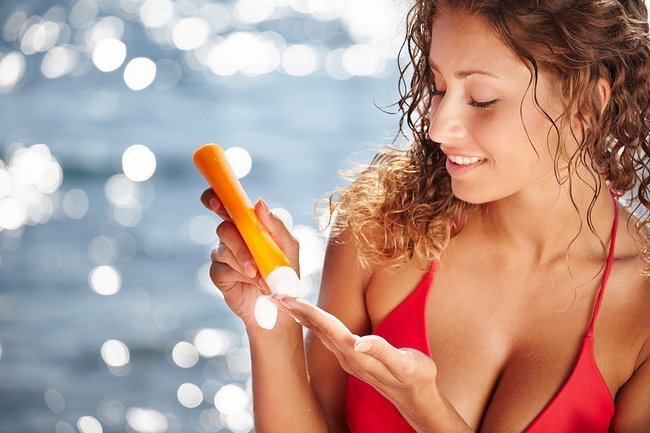- Make It Yourself Lavender Heart-Shaped Bath Bombs!
- 20 Things You Never Knew About “Down There”
- 12 Best Foods For Those Suffering From Arthritis Pain
- 12 Personal Hygiene Mistakes Almost Everyone Makes (Mom Never Told You About #4!)
- 15 Medicinal Plants And Herbs From The Cherokee People
- 12 Mind-Blowing Benefits Of Drinking Coconut Water During Pregnancy
- 12 Outstanding Winter Foods That Won’t Fatten You Up Like A Christmas Turkey
Besides Ourselves, What else is Sunblock Poisoning?

Photo credit: bigstock
Summer is just about over but the sun is still strong so people are still diligently using sunscreen. You have probably already read about how many of the ingredients in sunscreen are toxic and can cause users serious health problems, but did you know that if you use those toxic types of sunscreen and you go into the ocean, lake, or river, that it washes off you and goes into our waters? This means that these poisonous chemicals are going into our waters and marine life and causing unbelievable damage.
Sunscreens are often made with chemicals such as zinc oxide, titanium oxide, and parabens, which do block ultraviolet light from the sun from reaching our skins, but in the last few decades, many manufacturers are now using these same ingredients but in nanoparticles. This makes sunscreens less greasy and easier to apply, but their environmental and health issues are virtually unknown.
Research done previously showed that, in sunlight, nanoparticles of titanium dioxide could react with water to make potentially toxic chemicals such as hydrogen peroxide. Hydrogen peroxide, in large enough amounts, are known to be deadly to a type of algae known as phytoplankton, which, if you remember from your high school days, forms the base of the oceans food chain, as well as producing much of the planets oxygen.
Sunscreen chemicals have been found in numerous water sources, but especially in our oceans, and there is also evidence that these chemicals are causing the bleaching effects of coral reefs in tropical parts of the world.
Algae normally live on coral and gives the coral food, as well as its color. Elevated water temperatures and water pollution can cause the coral to die. When it dies, it loses its color, leaving the reefs white in appearance, almost as if someone bleached it.
Continue to Page 2

Photo credit: bigstock
We add this pollution to the oceans when we wear sunscreens with toxic chemicals that were off into the waters. Researchers posted a report in National Geographic that said they estimate that between 4 and 6 thousand tons of sunscreen washes off of swimmers every single year. Also, they state that as much as 10 percent of the world’s coral reefs are threatened by this sunscreen induced bleaching effect.
It’s estimated that sun screen and tanning lotion use has increased, on average, as much as 7 percent every year over the past 5 years. Researchers have tested ocean waters from Palmira beach off of Majorca Island in the Mediterranean. This beach is visited by at least 10,000 tourists every day.
Researchers found in their laboratory tests that the silica or alumina that coats these sunscreen nanoparticles (to prevent skin irritation) dissolve in water and release the titanium dioxide into ocean waters.
Using data on tourist information, as well as findings in laboratory tests, these researchers estimate that as much as 8.8 pounds of titanium dioxide is being put into the ocean every single day during the summer, just on this beach. This means that hydrogen peroxide levels could be as much as 400 times higher than their normal level. Imagine the devastating impact this could have on ocean life!
Although companies market sunscreen as a means of reducing your risk of developing skin cancer, many research studies show that the toxic chemicals in sunscreen actually have the opposite effect. Some studies even go back as far as 2000, showing that those who use sunscreens actually have higher incidences of skin cancer than among those who do not use sunscreen.
Some research studies have also shown that avoiding the sun entirely can be more dangerous to your health than skin cancer itself. Getting safe exposure to the sun is the best way to get sufficient levels of vitamin D, which not only improves your immune system, but has been shown to fight cancer cells. In fact, a study in 2008 showed that if every single American doubled their sun exposure, more than 10 times more lives could be saved due to less cases of cancer, than might be lost from possible increased rates of skin cancer.
Instead of using these toxic sunscreens, try covering the body when you are not swimming. You can also try other, non-chemical products such as shea butter, plant oils, or natural waxes.
Sunscreen manufacturers make big bucks from the production of cheap and toxic sunscreens, but we can make better decisions. Choose more organic solutions, and cover up whenever possible.
Sources:
































